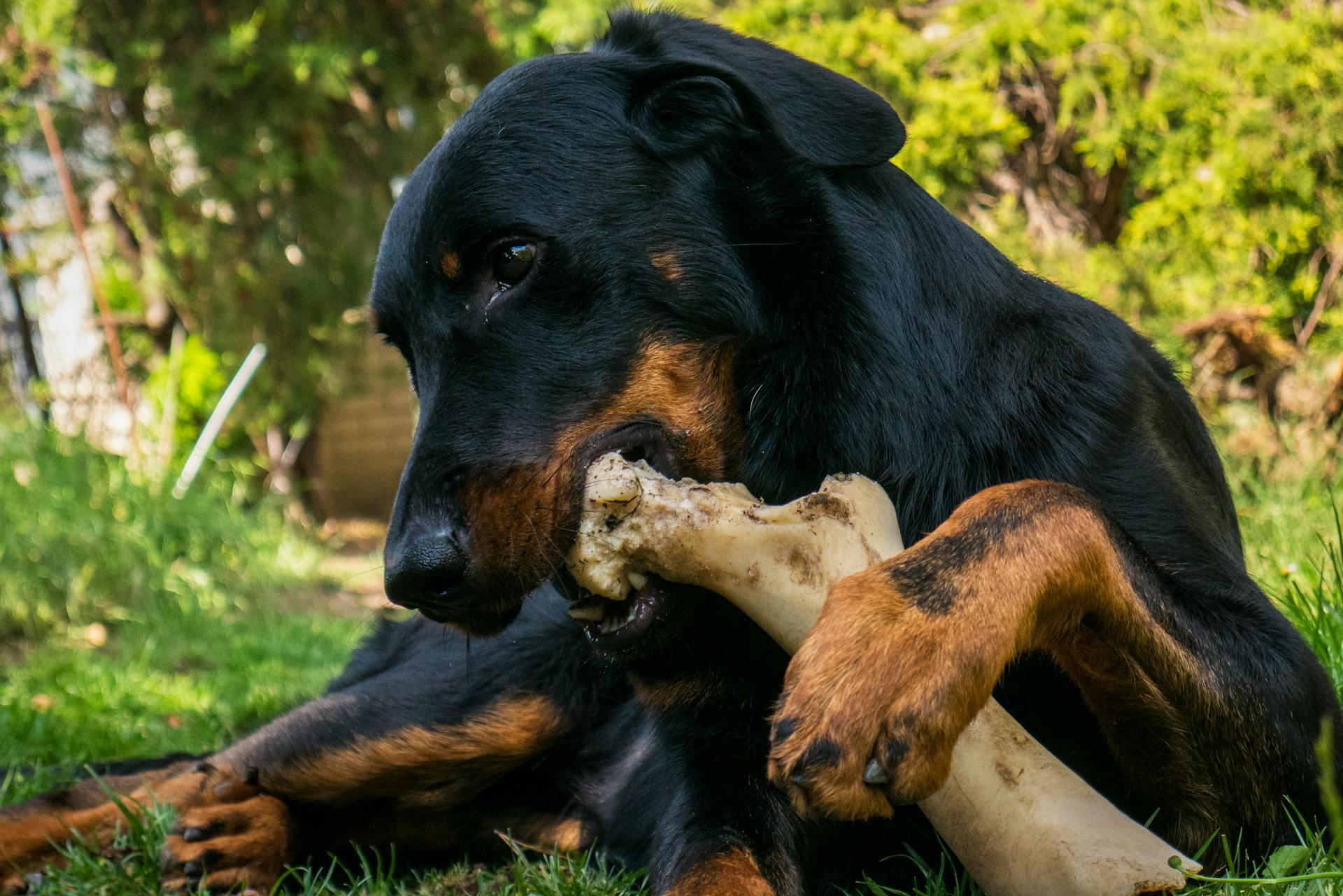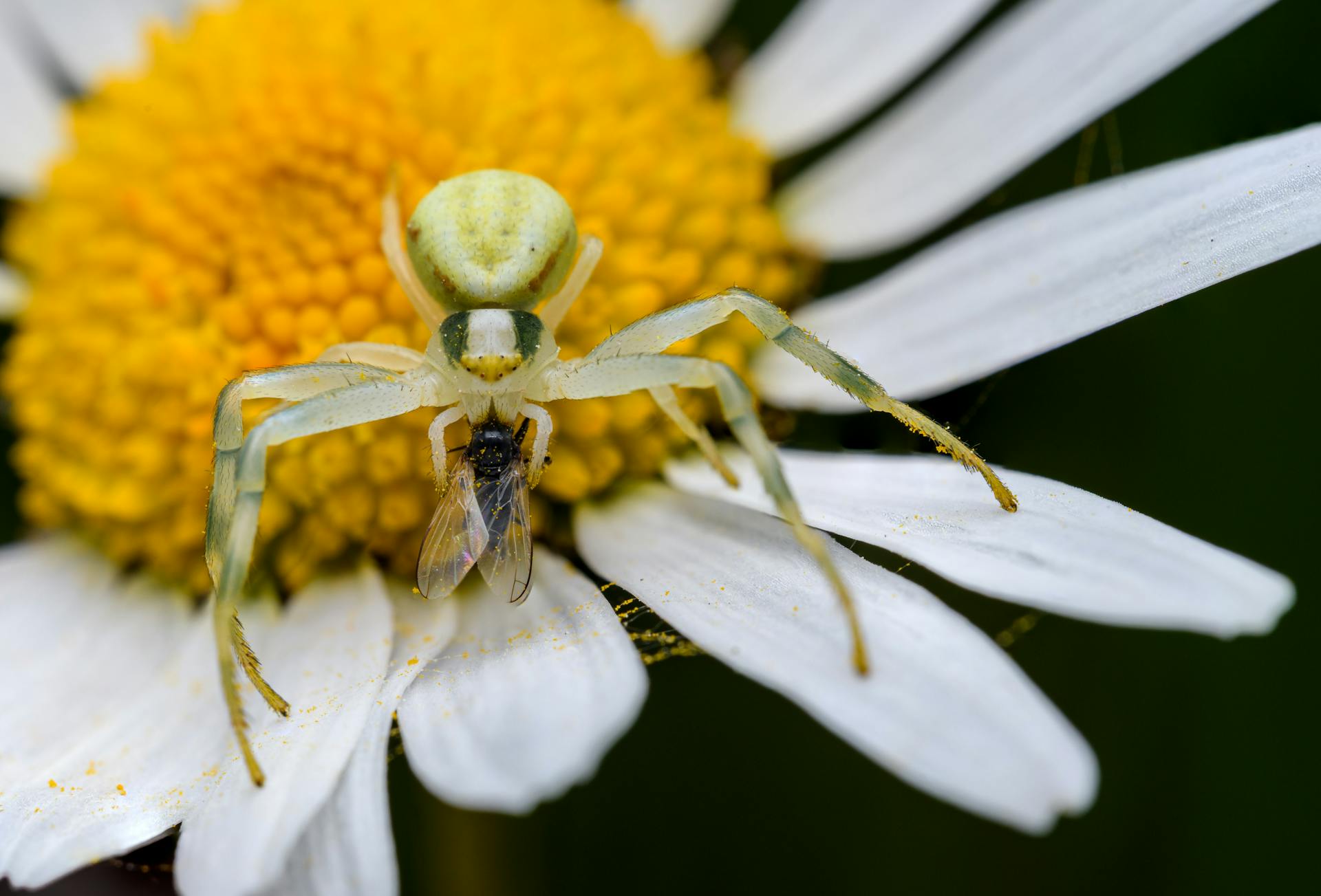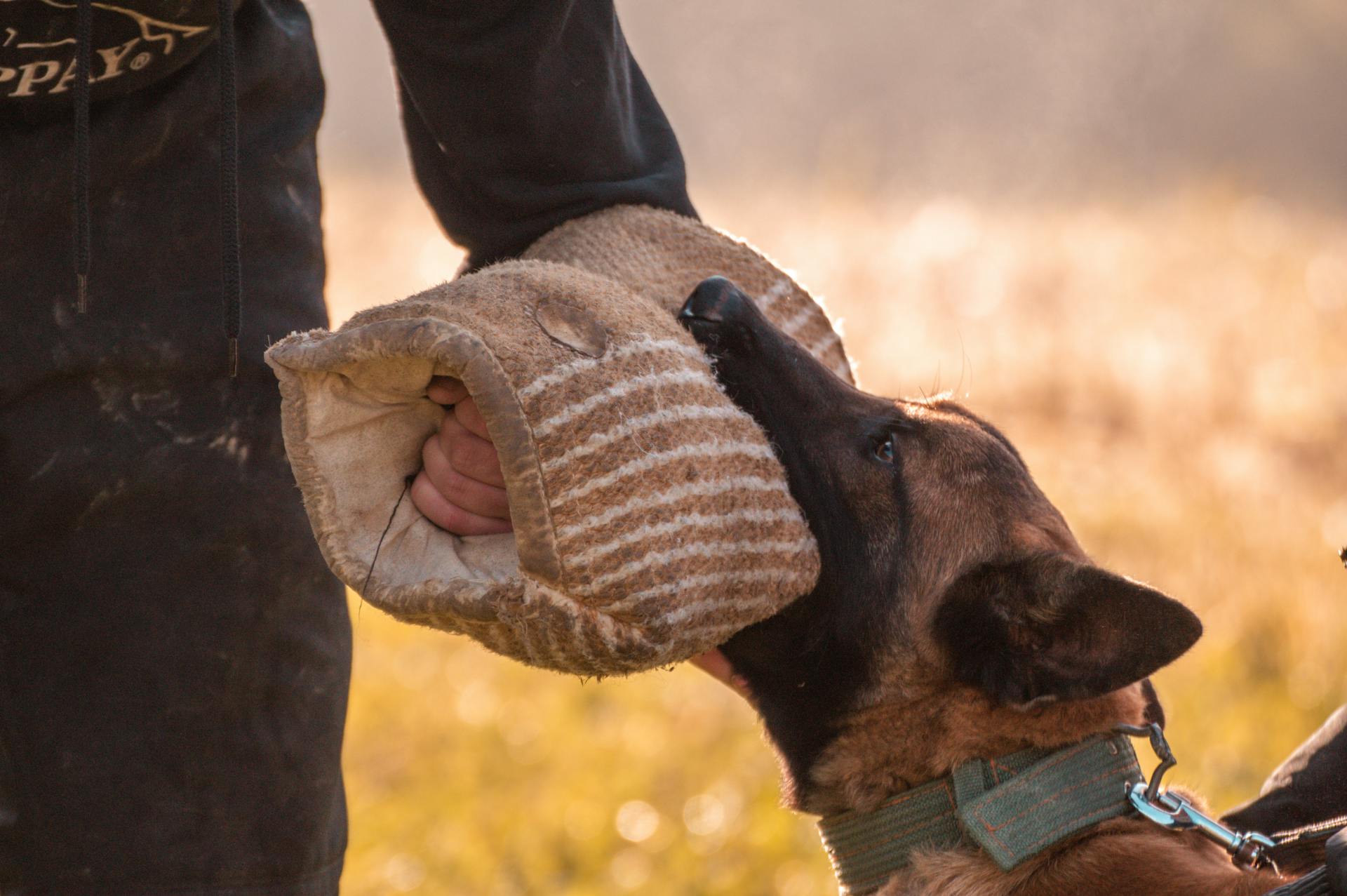
Training a well-behaved dog requires patience and consistency.
According to studies, dogs that are socialized early in life are less likely to develop aggression problems, including biting.
Consistency is key when training a dog not to bite. This means setting clear rules and boundaries from the start and sticking to them.
Dogs that are not properly socialized may become fearful or anxious, leading to biting behavior.
Understanding Inhibition
Bite inhibition is the most important part of a dog's education, and it's essential to teach your puppy to control the force of their bites.
Puppies naturally nip at each other while playing, but if they bite too hard, their littermates will likely yelp, warning them to stop.
This natural behavior can be applied to teaching bite inhibition, where you startle the puppy and then redirect their attention to something appropriate to chew on.
If your puppy bites you, making a high-pitched "ow!" sound can help them understand that they shouldn't bite down hard, but be cautious, as this might get them more worked up.
Some dog owners use a bitter spray to deter puppies from chewing and biting on objects.
Here's an interesting read: Puppy Shock Collar
What Is Inhibition?
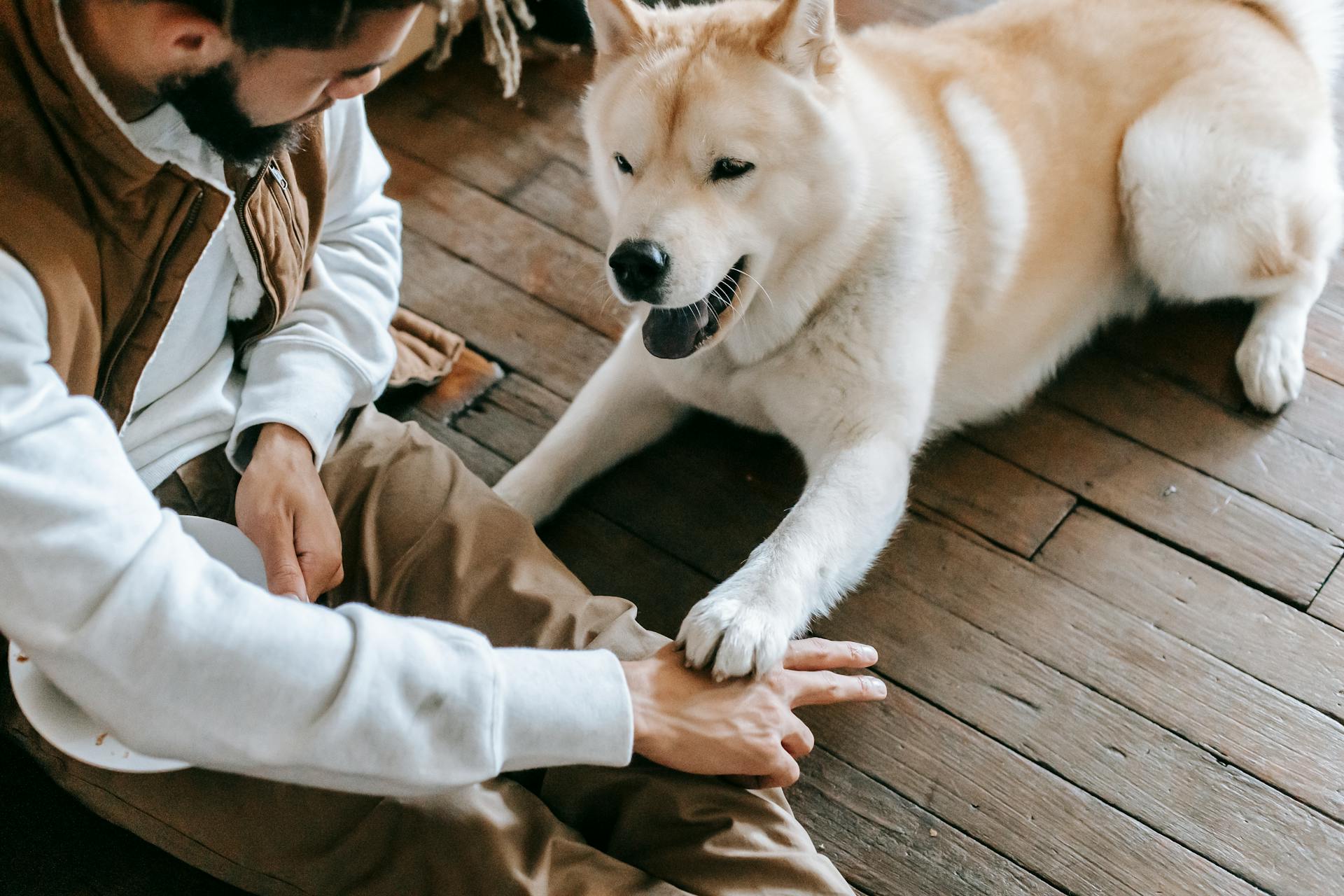
Inhibition is a crucial aspect of a dog's education, and it's essential to understand what it is. Bite inhibition refers to the degree to which dogs learn not to use the full force of their mouths on people and other dogs.
Puppies typically learn bite inhibition from their littermates, and it's a natural behavior that helps them develop social skills. If a puppy mouths too hard, startling them with a puppy-like sound can interrupt the behavior.
The sound of a yelp, like "Aaarp!", is often effective in stopping a puppy's biting. This technique takes advantage of the pause in behavior that follows the yelp, allowing the puppy to redirect their energy to something more suitable, like a chew toy.
By redirecting a puppy's biting to a suitable chew toy, you're helping them develop good habits and learn to control the force of their bites.
Related reading: Pitbull Dog Bite Force
Understanding Why Puppies
Puppies bite because it's a natural instinct they inherited from their mother, who communicated with them through mouthing and biting.
Their mouths explore the world in the same way human babies use their hands and put things into their mouths. This is especially true during teething, when they're trying to find relief from the discomfort.
Puppies nip at each other while playing, and if they bite too hard, the other dog will likely make a loud yelp sound, warning the puppy, "Hey, that hurt!"
Their natural want to chew is not something to suppress, but rather guide towards appropriate chew toys.
Puppies will continue to bite as they mature, but with proper training, they can learn what to bite and what's unacceptable.
Why Do Puppies Bite?
- Teething and natural instinct
- Exploring the world with their mouths
- Imitating their mother's behavior
- Playful behavior
By understanding these reasons, you can better approach training your puppy to control their biting and develop good habits.
Early Training
Early training is crucial for preventing biting behavior in dogs. Puppies typically start teething at around 3-4 months old, which can trigger nipping and biting as they explore their environment.
To address this, it's essential to establish a consistent training routine. According to the article, puppies can learn basic obedience skills in as little as 5-10 minutes a day, making short training sessions a great starting point.
By incorporating positive reinforcement techniques, such as offering treats and praise, you can encourage good behavior and discourage biting.
Early Experiences
Early experiences play a crucial role in a puppy's development, particularly when it comes to bite inhibition.
Littermates are a puppy's first teachers, and it's beneficial for puppies to stay with their litter for about two months to learn from each other.
Puppies use their mouths to tug or gnaw on their siblings' ears, tails, paws, and loose skin during play, which helps them learn to control the pressure they exert with their mouths.
Singleton puppies and those taken from their litter before the age of five or six weeks often lack proper bite inhibition, as they miss out on their littermates' feedback.
Puppies need their littermates' feedback to learn to control the pressure they exert with their mouths, and this is a natural part of their development.
As puppies play, they use their mouths to explore the world, much like human babies use their hands and put things into their mouths.
For more insights, see: Dog Impulse Control Training
Start with the Hardest
Starting with the hardest bites is a crucial step in early training. This approach helps prevent overwhelming the puppy by teaching them not to mouth so hard rather than not to mouth at all.
Puppies are naturally inclined to explore their surroundings with their mouths, but it's essential to teach them to do so gently. By focusing on the hardest bites first, you're giving them a clear understanding of what's expected.
Employing this approach with every instance of mouthing can be overwhelming to the puppy. So, the first goal is to teach the puppy not to mouth so hard rather than not to mouth at all.
Here's an interesting read: First Night Crate Training
Children and Puppies
Children and puppies can be a wonderful combination, but it's essential to supervise their interactions closely. Dogs should never be left alone with children.
A child's first reaction to being nipped or mouthed by a puppy is to push the puppy away with their hands and arms, or run and/or squeal and make noise. This can be a challenging situation for parents to manage.
Parents should monitor closely all interactions between their children and dogs, as a child's behavior can be misinterpreted by the puppy as play.
Broaden your view: Dogs from Puppy Mills Behavior
Teaching Techniques
Teaching your dog not to bite requires patience, consistency, and the right techniques. One effective way to teach bite inhibition is to startle and redirect the puppy, making a high-pitched "ow!" sound if they bite too hard, and then giving them something to chew on.
To teach your puppy to bite softly, you can use a time-out system, where you stop play and leave them alone for a minute when they give you a hard bite. Each week, you can increase the level of biting allowed before giving a time-out.
Redirecting your puppy's chewing onto acceptable objects is also crucial. Offer them a small puppy-safe chew bone or toy whenever they're petted, and alternate which hand does the petting and which one has the chew toy.
Positive reinforcement techniques, such as rewarding your puppy with treats and praise when they use gentle mouthing or avoid biting altogether, can also be helpful. Teaching a "no bite" command and associating it with pleasant outcomes can increase the likelihood of your puppy repeating the desired action.
Take a look at this: How to Teach a Dog Obedience
Here's a table summarizing some key techniques:
Remember, consistency and patience are key when teaching your puppy not to bite. Be patient with their progress, and don't get discouraged by setbacks – with time and effort, your puppy will learn the desired behavior.
If this caught your attention, see: Shock Collar for Puppy Biting
Managing Behavior
Managing Behavior is key to preventing biting. Puppies learn quickly through positive reinforcement, so be sure to reward calm and quiet behavior with a "good dog" or a treat.
To redirect biting, shift your puppy's focus to a toy or chewable. Make your hand into a fist if your puppy is biting your fingers, as it's less fun to play with and they'll likely lose interest.
Providing a range of toys and chewables is essential for redirecting biting. Keep these items nearby so you can quickly switch your puppy's focus to the proper items.
Here's an interesting read: Are Dachshunds Clingy
Apply Lighter Pressure
Applying lighter pressure is a crucial step in managing your dog's behavior. This involves redirecting your dog's attention after they have exhibited medium-force bites.
Start by working on lighter bite pressure, which is the next step after inhibiting the hardest bites. Spend time at each level to ensure your dog has a firm understanding.
Redirecting your dog's attention after medium-force bites is essential to prevent them from escalating to harder bites.
Worth a look: Force Free Dog Training
Prevent the Pounce
Managing your puppy's behavior can be a challenge, especially when they start pouncing on your legs or feet as you walk. This is a common playful puppy behavior that can be easily addressed with the right technique.
Holding a high-value treat next to your leg as you walk can help your puppy learn to walk nicely alongside you. This is a simple yet effective way to redirect their attention and encourage good behavior.
Using a high-value treat can also be useful when teaching a puppy to walk on a leash. By associating the treat with the desired behavior, you can help your puppy learn to walk calmly by your side.
A different take: Training Dog to Walk beside You
Utilizing Redirecting Strategies
Redirecting your puppy's behavior is a crucial part of managing their biting and chewing habits. It's not about suppressing their natural instincts, but rather guiding them towards more suitable behaviors.
To redirect your puppy's biting, start by making your hand unappealing. Puppies tend to go after movement, so if they're biting at your fingers, make your hand into a fist. It's likely they'll become disinterested in playing with a less fun target.
Check this out: Dog Training Hand Signals Pdf
Providing your puppy with a range of toys and chewables is essential for redirecting their behavior. This will signal to them what is suitable to bite and what is not. Keep these toys nearby so you can shift their focus to the proper items if they begin to bite.
Redirecting strategies can be as simple as holding a high-value treat next to your leg as you walk. This will help your puppy learn to walk nicely alongside you, rather than pouncing on your legs or feet.
A different take: The Perfect Walk Dog Training
Class and Routine
Enrolling your puppy in a well-run class is a great idea - it's a chance for them to socialize with other dogs and learn how to interact politely. An AKC S.T.A.R. Puppy class is a good place to start.
Patience and consistency are key to teaching your puppy to be polite with their mouth. Some puppies may back off during one play session, and come at you teeth first in the next, but that doesn't mean they're vicious.
Establishing a consistent routine for training is crucial, and teaching bite inhibition is no exception. Set a schedule for training sessions, aiming for short, frequent ones to keep your puppy occupied and prevent them from being overwhelmed or bored.
Broaden your view: Master Class Dog Training
Quiet Time or Potty Break
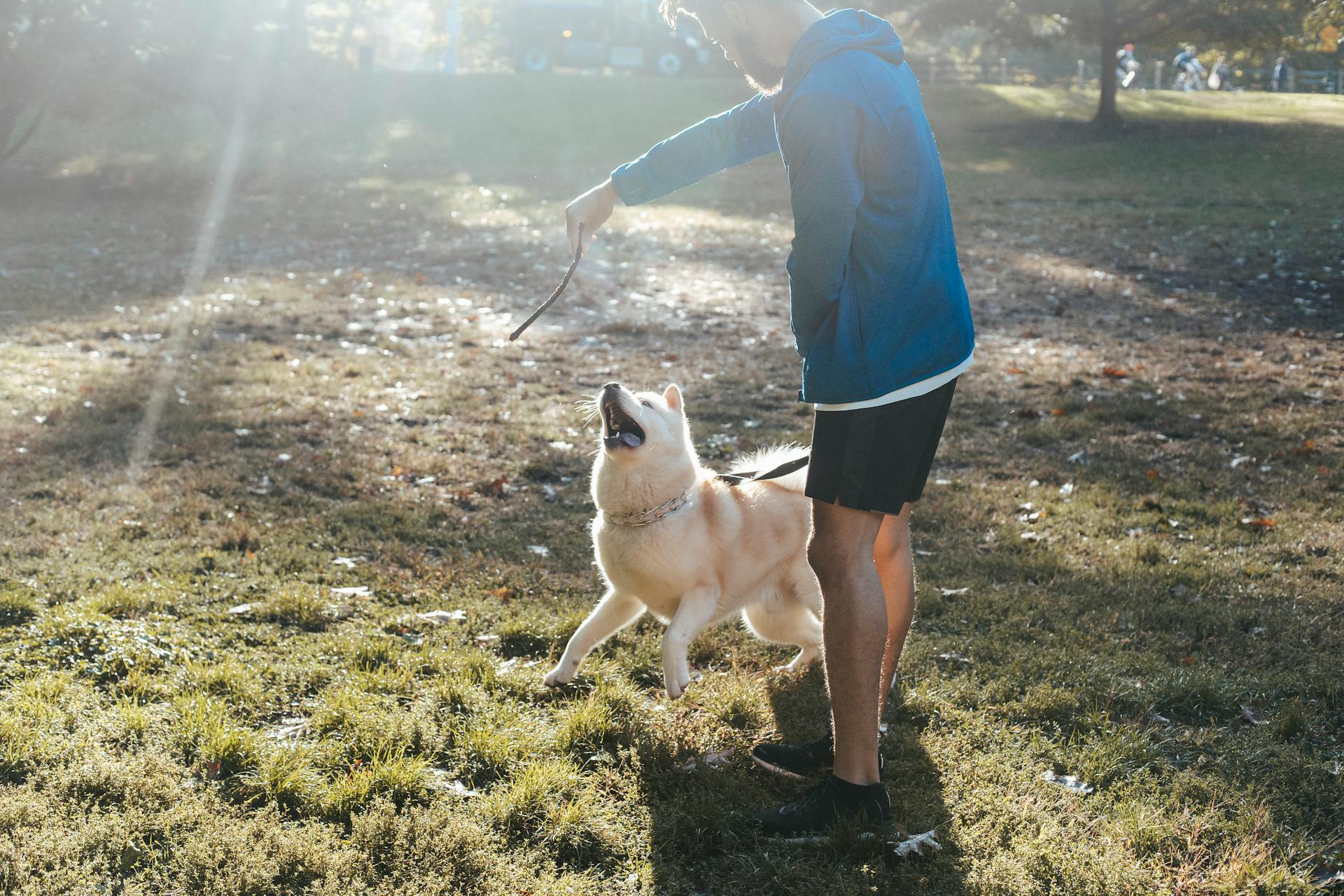
In the midst of a chaotic day, it's easy to overlook the simplest solutions to a biting puppy's behavior. Sometimes a biting puppy is really an over-tired puppy, and they need to be put in a quiet space or crate to take a nap.
A potty break can also be a lifesaver, giving your puppy the chance to re-focus and calm down.
Puppies may need a potty break because they're hungry or thirsty, so make sure to check their food and water levels before trying to calm them down.
Putting your puppy in a quiet space or crate can be a game-changer, helping them to recharge and come back to you feeling calm and focused.
Explore further: Calm Dog Training
Class Expectations
Puppy socialization classes are a must for teaching your little one to be polite with their mouth. More than 90 percent of puppies will respond to the interrupting and redirecting method if used correctly and consistently.
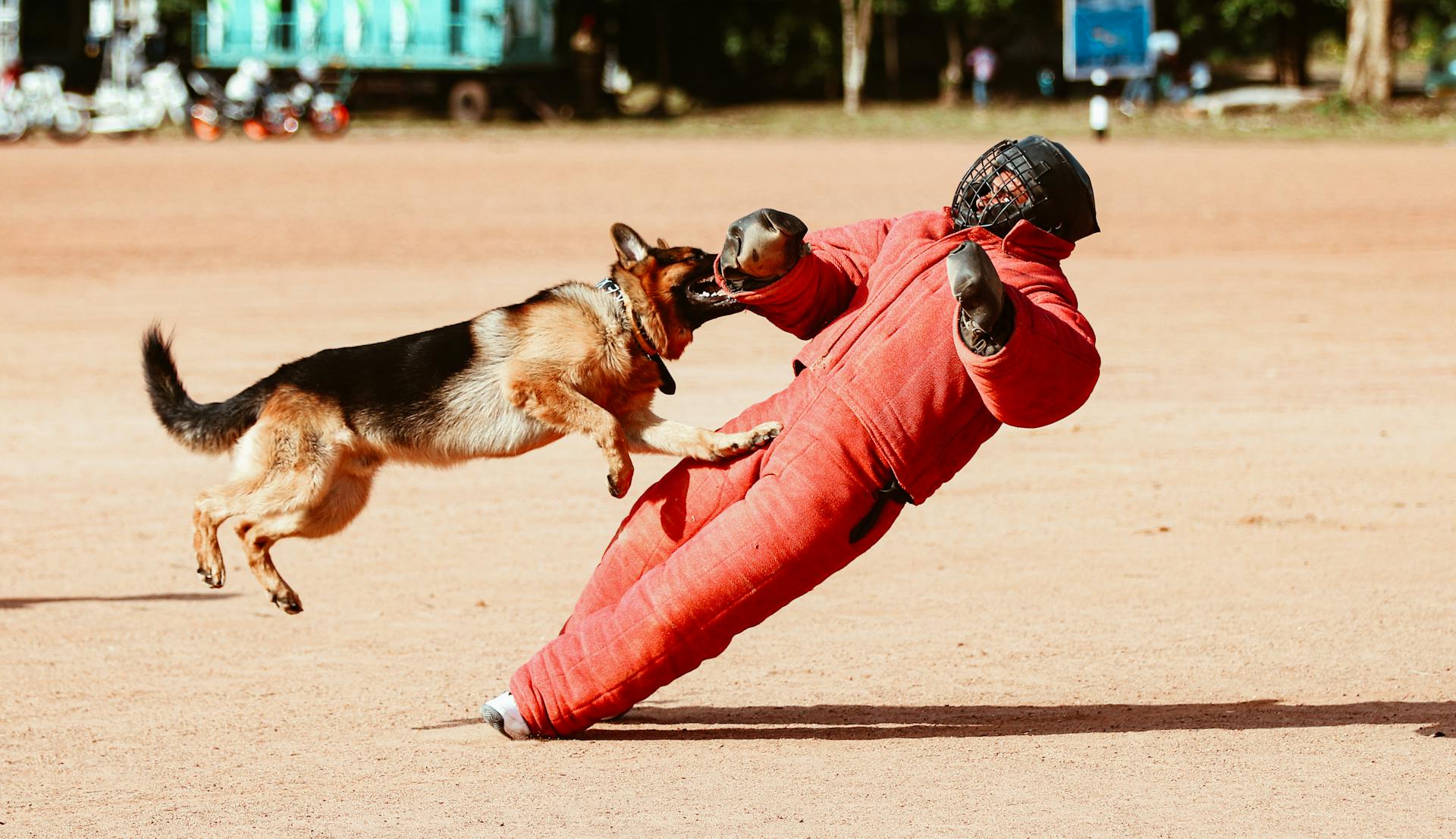
Expecting your puppy to learn in one play session is unrealistic, as some may back off and then come at you teeth first in the next. Patience and consistency are the keys.
Puppy classes like AKC S.T.A.R. Puppy classes provide a chance for your puppy to socialize with other dogs. If your puppy fails to respond to high-pitched yelps or a deep-voiced "Hey!" or "Ouch!", walk away so they learn that biting brings an end to the fun.
If you haven't been able to moderate your puppy's play biting by the time they're six months old, it's a good idea to consult an experienced dog trainer or animal behavior specialist.
Establishing a Routine
Establishing a routine is key to success in many areas of life, and it's no different when it comes to training a puppy. Consistency sends clear signals and reinforces desired behavior across all family members.
Dogs thrive on routine, so adopting a consistent training program will help your puppy understand what's expected of them. Consistency makes the learning process easier for your beloved buddy.
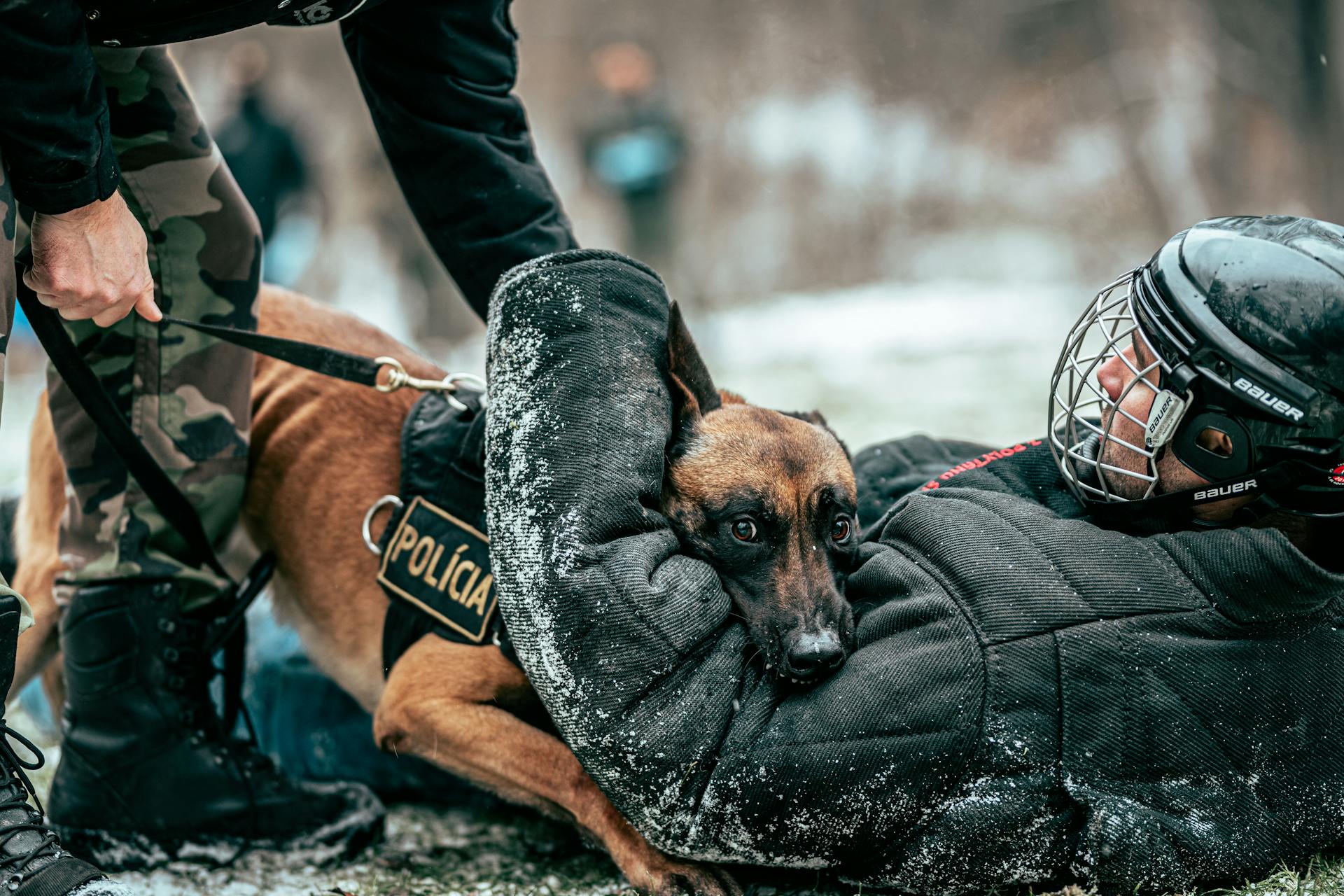
Setting a schedule for training sessions is a great way to keep your puppy occupied and prevent them from being overwhelmed or bored. Aim for short, frequent sessions instead of extended, random ones.
Choose a peaceful and distraction-free space for training, and make sure everyone in the family is on board with the timetable. This will help maintain consistency and make the training process smoother.
Discover more: How Long Should a Dog Training Session Be
Frequently Asked Questions
What command stops dogs from biting?
The "leave it" command is a powerful tool to stop dogs from biting by teaching restraint. Mastering this command can help prevent unwanted biting and strengthen your bond with your dog.
Sources
- https://www.thewildest.com/dog-behavior/dog-bite-inhibition
- https://www.akc.org/expert-advice/training/stop-puppy-biting/
- https://www.oregonhumane.org/portland-training/teaching-bite-inhibition-and-dealing-with-rough-puppy-play/
- https://www.aspca.org/pet-care/dog-care/common-dog-behavior-issues/mouthing-nipping-and-play-biting-adult-dogs
- https://www.upstatecanine.com/blog/6-proven-methods-for-teaching-your-puppy-not-to-bite/
Featured Images: pexels.com
